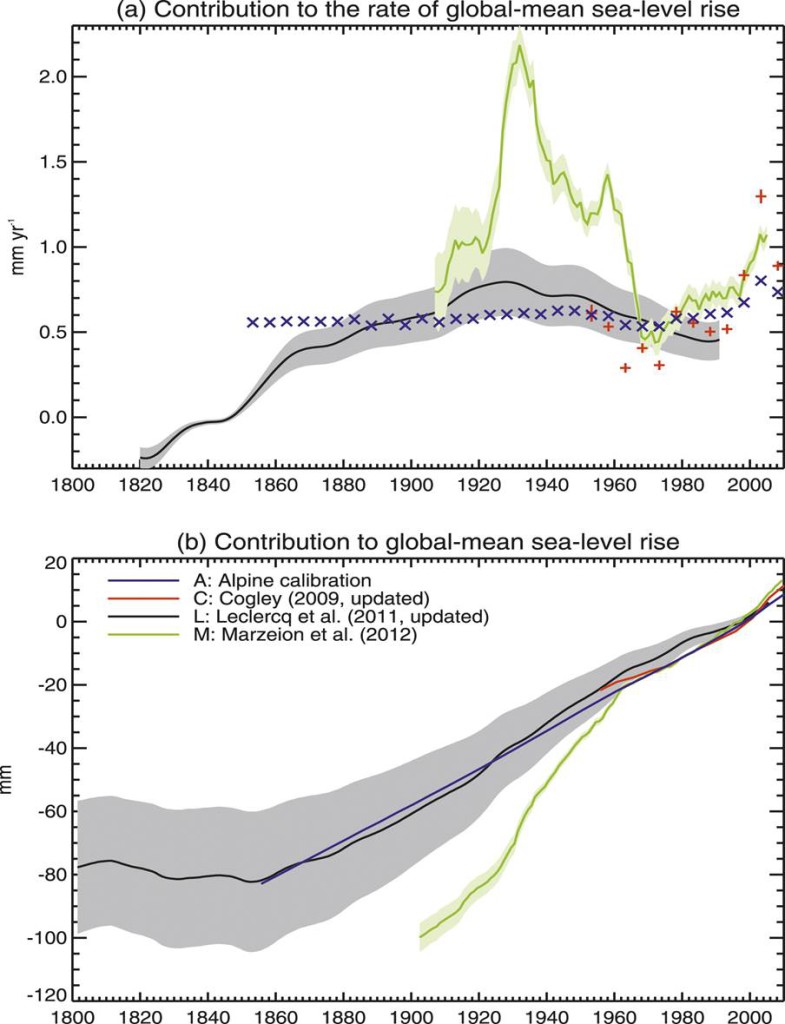Are CO2 Emissions Driving Ice Melt, Sea Level Rise?
By guest writer Kenneth Richard
According to the below graph (Fig. 2 a) found in Gregory et al., 2013 in Journal of Climate (“Twentieth-Century Global-Mean Sea Level Rise: Is the Whole Greater than the Sum of the Parts?”), there was a very substantial increase in the glacier and ice sheet melt contribution to sea level rise in the early 20th century, reaching up to 2 mm/year sea level rise equivalent.
Source: Gregory et al., 2013 in Journal of Climate
In recent years, the documented rise in sea levels contributed from glacier and ice sheet melt has not come close to reaching the high levels attained during the 1920s and 1930s period as documented by Gregory et al., 2013.
For example according to Shepherd et al., 2012 (see below), the total ice sheet melt contribution from the Antarctic (AIS) and Greenland (GIS) ice sheets combined was 0.59 mm/year (~2.3 inches per century) during the 1992-2011 period and the total ice sheet or glacier melt from all other land sources (not the AIS or GIS) was 0.41 mm/year (~1.6 inches per century) for 2003 to 2010 according to Jacob et al., 2012 (see below).
Together, the total melt contribution from global land ice was about 1 mm/year (~4 inches per century) through the first decade of the 21st century, which is still well below the melt rates achieved during the 1920s and 1930s.
Interestingly, during the 1920s to 1930s period of very high glacier melt rate contributions to sea level rise, human CO2 emissions were flat and only averaged about 1 GtC/year (see graph below).
In contrast, during the 1990s to 2010/2011 period, CO2 emissions rates reached 6 to 9 GtC/year.
Image: www.naturesconfluence.com/uploads.png
Unanswered question
If anthropogenic CO2 emissions are truly driving ice sheet and glacier melt contributions to sea level rise, why was the melt contribution significantly higher during the 1920s and 1930s when CO2 emissions rates were flat and about 1/6th to 1/9th of what they’ve been in recent years?
References:
Shepherd et al., 2012: sciencemag.org/content/338/6111/1183
“Since 1992, the polar ice sheets [Antarctica and Greenland] have contributed, on average, 0.59 ± 0.20 millimeter year−1 to the rate of global sea-level rise.”
Jacob et al., 2012: www.nature.com/nature/journal/v482/n7386/abs/nature10847.html
“Here we show that GICs [glaciers and ice caps], excluding the Greenland and Antarctic peripheral GICs, lost mass at a rate of 148 ± 30 Gt yr−1 from January 2003 to December 2010, contributing 0.41 ± 0.08 mm yr−1 to sea level rise.”







Glaciers in the North Cascades of Washington retreated upvalley more than a kilometer more in the 1930s and 1940s than since 1980. The present termini of glaciers on Mt. Baker are about a km downvalley from their 1950 termini.
That’s consistent with the temperature records.
http://www.c3headlines.com/2012/07/extreme-global-warming-noaa-confirms-modern-us-warming-not-as-hot-vs-1930s.html
https://www.youtube.com/watch?v=03Bt6b8PPP0#t=24
Thanks. Excellent resource!
Here’s another Evan Sayet video, going into a bit more detail on why products of Leftist brainwashing are so screwed up.
http://savevidz.com/watch/pSMPU0JhJCw/evan-sayet-on-why-liberals-think-conservatives-are-evil.html
Hello:
I’ve tried to look at the youtube video… but it is about a guy talking about Donald Trump… wrong link?
Hi Don.
I have used your graphs of those Mt Baker glaciers many times. 🙂
What is interesting is just how closely they match the swings of the AMO, despite being on the other side of America from the Atlantic.
Here I have taken Reykjavik temperatures and turned it sidewards to match the orientation of your charts.
http://s19.postimg.org/qzl5p322b/Rey_vs_Ross.jpg
And here we see the match of Reykjavik to the AMO
http://s19.postimg.org/5vfcwbc8j/amoreyk.jpg
P.S. – I thoroughly enjoyed this very informative video of yours.
https://www.youtube.com/watch?v=4LkMweOVOOI
Someone asked the British public what they think
http://www.bbc.com/news/uk-35861444
[…] Glacier melt has in fact slowed considerably, studies show: [link] […]